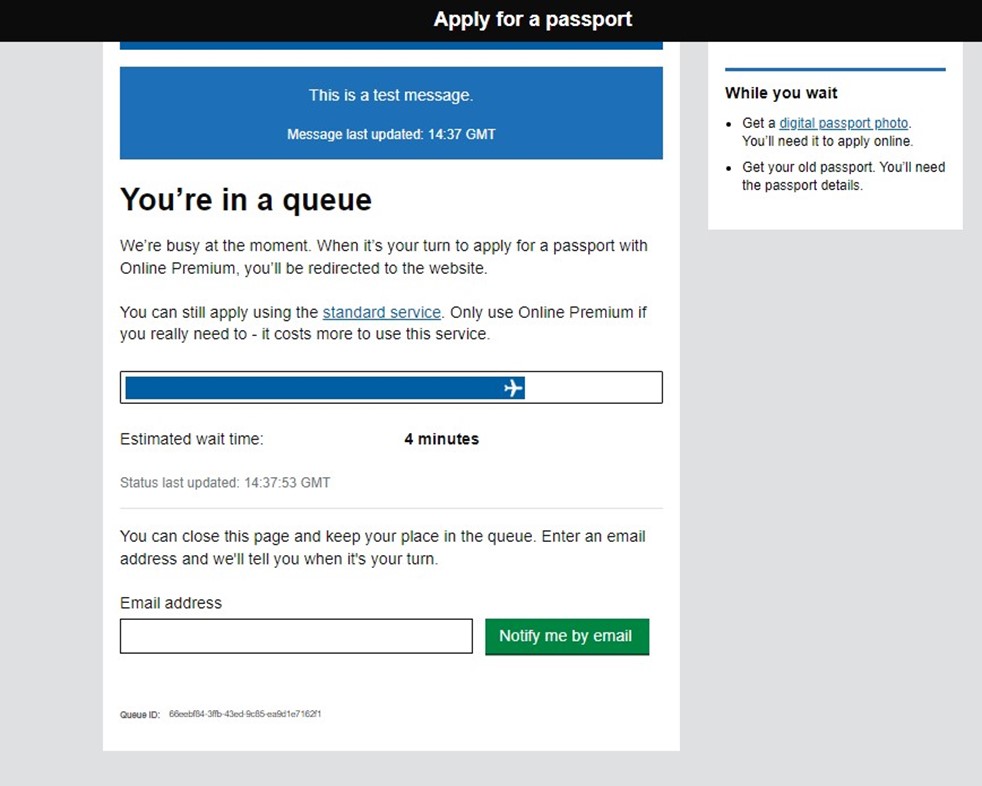How to ensure your website is prepared for the surge in voter registrations

Every election cycle for the past decade has brought with it high-profile crashes of registrations sites at critical moments. “We weren’t expecting so much traffic,” is no longer an excuse citizens or the media will accept. Discover how major public sector organizations prepare their websites for surging traffic with a virtual waiting room.
As the November general election approaches, is your voter registration website prepared to handle demand?
Last election, voter registration surges crashed websites in Florida, Virginia, Minnesota, and Pennsylvania.
These crashes not only frustrated citizens looking to fulfil their democratic duty, they also lead to lawsuits, emergency extensions of voting periods, and countless social media complaints and negative headlines.
And the voter registration site crashes are ramping up again. In May of this year, voter registration for just the primary elections crashed Georgia’s My Voter Page site.
“In the years I’ve been doing this I’ve never seen it be down for this long,” said Stephanie Ali, policy director with the New Georgia Project. “So we have to have our confidence that this is getting fixed, that this is going to be stronger and that this is going to handle a higher volume going into November and frankly beyond.”
Discover why public sector organizations in New Hampshire, Minnesota, and Oregon use virtual waiting rooms to handle demand during surging traffic, how these solutions work, and why it’s so hard to keep your site online during large spikes in activity.
Public sector organizations across the globe use virtual waiting rooms to protect their websites from surging traffic and ensure a fair and reliable online experience during high-demand registrations.
Many public sector orgs have learned the hard way that website traffic is unpredictable and can spike suddenly. Voters rush your website in the thousands if it’s mentioned on primetime news, linked to on a major news site, or even posted on Instagram by a public figure.
A spokesperson for the Florida Department of State, for example, told The Markup that “an unprecedented 1.1 million requests per hour” caused their voting website to crash.
And when Taylor Swift posted about vote.org on Instagram, the site reported a 1,226% increase in traffic within an hour. Andrea Hailey, their CEO, said, "Our site was averaging 13,000 users every 30 minutes.”
Web traffic surges cause sites to slow down, produce errors, and crash altogether. These site problems:https://queue-it.com/media/ppcp1twv/product-drop.jpg
- Frustrate citizens: voters who’ve set aside time to register are met with slow, buggy, and crashed sites, causing frustration and harming trust in government.
- Damage reputation: frustrated citizens turn to social media to complain, journalists write news articles about the failure, tarnishing your reputation.
- Drain resources: IT teams work frantically to restore the site, while service and marketing teams work on crisis management.
- Impact democracy: voters who try to register and can’t because of a crashed site may never return. “If you’re not maintaining critical infrastructure and it results in people not being able to vote, that’s voter suppression by inaction,” says Ryan Snow from the Lawyer’s Committee for Civil Rights under Law.

Source: Sam Morris, The Markup
“If you go down, it's the worst thing in the world. Because it’s part of your profession, it’s the service you have stewardship for. We’re held to having a worldwide 24-hour available service. And solutions like Queue-it help you ensure that’s maintained.”
Simon Watson, Technical Lead

That’s why, when faced with unprecedented demand, public sector orgs like The State of New Hampshire’s Department of Information Technology, ID.me, The Minnesota Department of Revenue and Minnesota IT Services, and the U.K.’s national passport office use a virtual waiting room.
By giving you control over online traffic, a virtual waiting room lets you:
- Ensure website performance: The virtual waiting room captures sudden surges in web traffic before they hit your site and allows you to control the rate at which visitors get access, ensuring you never exceed the technical capacity of your systems.
- Improve citizen experience: Virtual waiting rooms replace the frustrating experience of a website crash or slowdown with transparent and controlled access, including detailed wait information on a branded page that can feature important info like registration deadlines and necessary documentation.
- Deliver fair access: virtual waiting rooms provide sophisticated fairness mechanisms by ensuring first-come-first-served site access and allowing visitors to get notified when it’s their turn.
Virtual waiting rooms work by automatically redirecting online visitors to a waiting room when they enter a protected part of the user journey, for example visiting a landing page or proceeding to a registration form.
Visitors are seamlessly flowed from the site or page to a branded waiting room like the one below, where they see their number in line, their estimated wait time, and a progress bar. They experience a short, informed wait, then are flowed back to your site at the rate it can handle in a fair, controlled order.

While organizations often customize their waiting rooms both in style and in URL to look like the original site, the visitors in them are hosted on the virtual waiting room provider’s servers. This means no strain is placed on the target website’s servers while visitors wait for access.
Controlling the flow of traffic not only keeps your site online, it can also save you time and money. In a recent survey, Queue-it customers reported a 35% decrease in server scaling costs and a 50% decrease in the number of staff needed on-call during registrations.
Queue-it customers report a 35% decrease in server scaling costs and 50% decrease in the number of staff needed on-call during registrations.
Let’s look at some real-world examples that show how virtual waiting rooms prevents public sector website crashes during large spikes in activity like voter registrations.
When the New Hampshire Department of Information Technology (DoIT) initially launched vaccination registrations to citizens, “it just wasn’t a good citizen service experience,” says Denis Goulet, New Hampshire’s CIO. “People were having trouble with the system. We had partial transactions, data issues, and a not-so-elegant throttling system. Call center traffic skyrocketed.”
These issues incited immediate and immense pressure from both citizens and the media to get the next round of registrations right—which is why Goulet and his team implemented Queue-it.
New Hampshire’s DoIT knew their site could handle up to 1,000 visitors arriving per minute. What they didn’t know was when (or if) traffic would exceed this threshold. The team set up Queue-it’s virtual waiting room to monitor traffic to the registration page 24/7, and only activate if traffic exceeded 1,000 visitors per minute.
When traffic exceeded this amount, instead of the site crashing, visitors were automatically redirected to a customized waiting room. They experienced a short wait, then were flowed straight back to the website to register for their vaccinations in fair, first-come, first-served order.

As the chart below shows, web traffic remained mostly below the threshold the site could handle, but it was unpredictable. At around midnight on April 2nd, traffic suddenly spiked to over 1,500 visitors per minute. With Queue-it in place, the waiting room activated automatically, protecting the site and ensuring a seamless service experience for citizens.

“I loved the peace of mind Queue-it gave us—the knowledge that our systems weren’t going to crash ... I can count on one hand the number of times in my career I've implemented a new technology and it exceeded my expectations. Queue-it is one of those times, both in how easy it is to implement, and in how well it works.”
DENIS GOULET, NEW HAMPSHIRE STATE CIO

The virtual waiting room isn’t just used for voter and vaccination registration. It’s used by governments across the globe for a wide variety of digital services that are at risk of crashing due to spikes in traffic.
- The Minnesota Department of Revenue and Minnesota IT Services use a virtual waiting room to control traffic surges during popular rebate registrations.
- ID.me uses Queue-it to protect against activity spikes on their digital identification network, which serves over 130 million members across the U.S.
- The U.K. Government’s national passport service uses Queue-it 24/7 to protect against surges in traffic caused by news mentions.
- An Oregon Parks & Recreation organization uses Queue-it to handle the 800% traffic spikes they get during recreational activity registrations.
- The Catalonian Government has Queue-it’s virtual waiting room running on 10 distinct digital public services.
- A major European national tax authority uses Queue-it to handle the 2.5 million login attempts they get in the first two days of releasing annual tax returns to the public.

Home Office U.K.'s virtual waiting room for passport applications
They do. But at scale, every system breaks.
There is no “too big to fail” in the world of websites. Amazon, Walmart, Apple, the IRS—surging web traffic has taken all of them offline.
As Governor DeSantis said after Florida’s voter registration crash: “You can have the best site in the world, but sometimes there are hiccups … If 500,000 people descend at the same time, it creates a bottleneck.”
If you’re preparing for a surge in traffic during voter registration, you’ll want to optimize your website in many ways, including scaling your systems.
But scaling alone is expensive at best, and risky at worst. It can be:
- Expensive: Most websites are built to perform under their usual amount of traffic. Building a website that can handle huge traffic peaks that only come a few times a year is like buying a house with 10 extra bedrooms and bathrooms because your family comes to visit sometimes—it’s expensive, impractical, and unnecessary.
- Reactive: Because traffic levels are hard to predict and autoscaling takes time to kick in, your systems likely won’t be ready in the critical moment they’re needed.
- Risky: Even if autoscaling or pre-scaling could handle these surges, bottlenecks almost always emerge. As Gabriel Sterling, chief operating officer of the Georgia Secretary of State’s Office said of Georgia’s voter registration crash, “It’s not just the user, it’s the things they’re requesting. When you’re requesting to download a sample ballot, it’s a lot more capacity than it is if you’re just looking at your polling location.”
A virtual waiting room complements your autoscaling approach and gives you confidence your site will perform by controlling what other crash-prevention tactics can't: the flow of traffic to the site.
“Paying for super scaled up infrastructure is pointless when we don't need it most of the time. Queue-it offered that extra level of security and the ability to control the traffic spikes. It’s a very cost-effective way of managing demand."
KEVIN LEWIS, PRODUCT MANAGER, His Majesty's Passport Office
Every election cycle for the past decade has brought with it high-profile crashes of registrations sites at critical moments. “We weren’t expecting so much traffic,” is no longer an excuse citizens or the media will accept.
If you want to preserve citizen’s trust and stay out of the news this election cycle, you need to prepare your site for the fast-approaching surge in voter registrations.
With a virtual waiting room solution like Queue-it, you get confidence and peace of mind knowing this surge won't turn into a technical crisis. You can keep your site online, control your scaling costs, and save your reputation and your resources.